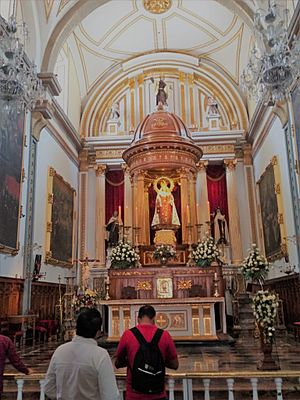Convent Church of Nuestra Señora del Carmen, Puebla facts for kids
The Church of the Virgin of Carmen is a beautiful old church in Puebla de los Ángeles, Mexico. It's also known as the Conventual Temple of Our Lady of Carmen. This church is a great example of Baroque architecture from the early 1600s. Inside, you can see amazing artwork and decorations. The main part of the church, called the nave, has famous paintings. One special painting is "The Holy Trinity" by Cristóbal de Villalpando. The church also has a stunning altar with a statue of the Virgin Mary, made by José Antonio Villegas Cora. Every year, on July 16, people celebrate a special festival for the Virgin of Carmen.
History of the Church
How the Church Began
The story of this church started in 1548. A city official named Hernando de Villanueva received some land. He wanted to build a small chapel there, dedicated to Our Lady of Remedies. This chapel was on a main road that later became a big street in Puebla. The next year, in 1549, the chapel got even more land.
A popular story says that Hernando de Villanueva got better after a fight. He believed the Virgin de los Remedios helped him. So, he built the chapel to thank her. In 1552, he gave the chapel to a group of tailors. They formed a brotherhood to take care of it. Some people think the chapel might have been linked to bullfights that used to happen nearby.
The Carmelites Arrive
In 1585, a group of monks called the Reformed Carmelites came to Mexico. They were also known as the Discalced Carmelites. They were one of the last religious groups to settle in Puebla. Other groups like the Franciscans and Dominicans were already there.
In 1586, the Bishop of Tlaxcala, Diego Romano, wanted a Carmelite monastery in Puebla. He offered them the old chapel of Our Lady of Remedies. The chapel was far from the city center and wasn't being cared for well. So, the Carmelites were asked to look after it. They started their training there in July 1586. Soon, the church became one of the most important and grandest in the city.
The Carmelites received the chapel and more land. They began building their new church and monastery. This happened on June 26, 1586. King Philip II of Spain and the Viceroy of Mexico approved the plan. The monastery grounds were very large. They even included big pear orchards. The Carmelites were known for their interest in farming. They are even credited with bringing alfalfa, a type of plant, to Puebla. They made sure their orchards had plenty of water from nearby springs.
The Old Cemetery
In front of the church, there used to be a cemetery called Santa María del Carmelo. The Carmelite monks started it in 1844. This was because new laws in 1827 said people could no longer be buried inside churches. Burying people inside churches was seen as unhealthy and could cause diseases. Other churches in Puebla also created outside cemeteries.
The law said cemeteries should be large enough for many years of burials. By 1878, burying people in special drawers or niches was stopped. New public cemeteries were created, like the Municipal Pantheon. The Carmelite cemetery was closed in 1880 and taken down in 1891. Even in the 1930s, some parts of the old cemetery, like arches, could still be seen. Today, mummies of a woman and a child found in this cemetery are kept in the Regional Museum.
See also
 In Spanish: Templo conventual de Nuestra Señora del Carmen (Puebla) para niños
In Spanish: Templo conventual de Nuestra Señora del Carmen (Puebla) para niños
- List of buildings in Puebla City


